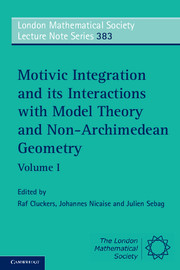Book contents
- Frontmatter
- Contents
- List of contributors
- 1 Introduction
- 2 Introductory notes on the model theory of valued fields
- 3 On the definition of rigid analytic spaces
- 4 Topological rings in rigid geometry
- 5 The Grothendieck ring of varieties
- 6 A short course on geometric motivic integration
- 7 Motivic invariants of rigid varieties, and applications to complex singularities
- 8 Motivic integration in mixed characteristic with bounded ramification: a summary
- References
1 - Introduction
Published online by Cambridge University Press: 07 October 2011
- Frontmatter
- Contents
- List of contributors
- 1 Introduction
- 2 Introductory notes on the model theory of valued fields
- 3 On the definition of rigid analytic spaces
- 4 Topological rings in rigid geometry
- 5 The Grothendieck ring of varieties
- 6 A short course on geometric motivic integration
- 7 Motivic invariants of rigid varieties, and applications to complex singularities
- 8 Motivic integration in mixed characteristic with bounded ramification: a summary
- References
Summary
Since its creation by Kontsevich in 1995, motivic integration has developed quickly in several directions and has found applications in various domains, such as singularity theory and the Langlands program. In its development, it incorporated tools from model theory and nonarchimedean geometry. The aim of the present book is to give an introduction to different theories of motivic integration and related topics.
Motivic integration is a theory of integration for various classes of geometric objects. One term in this “trade-name” seems unusual: motivic. What is a motive and in what sense is this theory of integration motivic? These questions lie at the heart of the theory. We will try to answer them in Section 4. First, we briefly introduce the two other protagonists of the present book: model theory and non-archimedean geometry. We will explain below how they interact with the theory of motivic integration.
Model theory
A central notion in model theory is language. A language ℒ is a collection of symbols, divided into three types: function symbols, relation symbols, and constant symbols. For every function symbol and relation symbol, one specifies the number of arguments. A formula in the language ℒ is built from these symbols, variables, Boolean combinations and quantifiers.
- Type
- Chapter
- Information
- Motivic Integration and its Interactions with Model Theory and Non-Archimedean Geometry , pp. 1 - 34Publisher: Cambridge University PressPrint publication year: 2011

